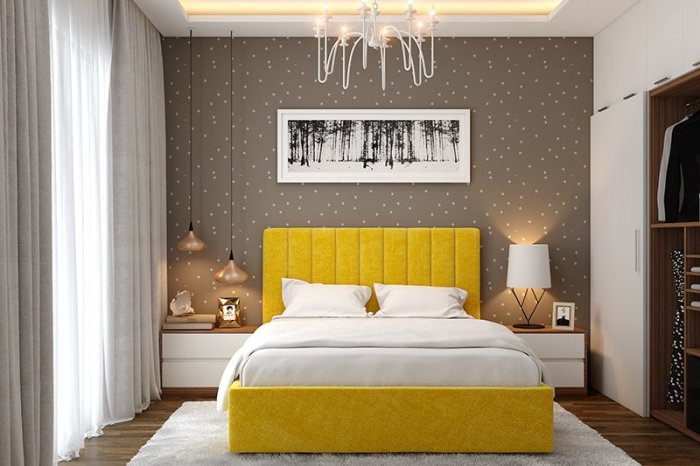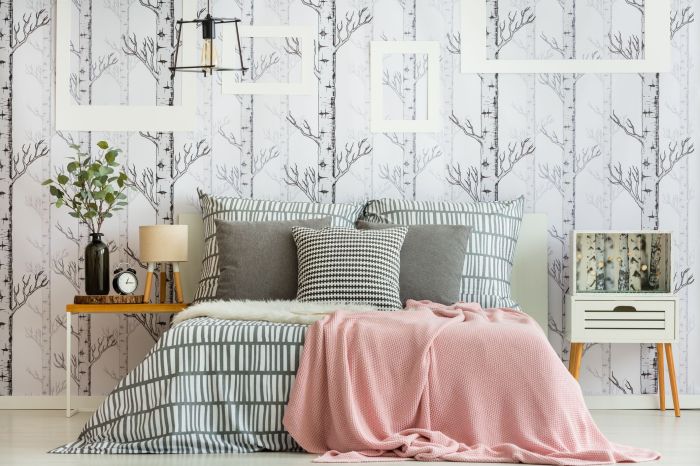Bedroom Wallpaper Styles

Wall paper design ideas for bedroom – Choosing the right wallpaper can dramatically transform the atmosphere of your bedroom, setting the tone for relaxation and rest. The style you select should reflect your personal aesthetic and complement the overall design of the room. Consider factors like lighting, furniture, and the size of the space when making your decision.
Choosing the right wallpaper can significantly impact your bedroom’s overall aesthetic. For a truly opulent feel, consider incorporating luxurious textures and rich colors into your design scheme. To find inspiration for achieving that high-end look, explore stunning examples of luxury bedroom design ideas , which often feature wallpaper as a key element. Then, translate those ideas into your wallpaper choices for a bedroom that reflects your personal style and elevates your space.
Five Distinct Bedroom Wallpaper Styles
Below are five distinct wallpaper styles, each offering a unique aesthetic and suitable for different bedroom types. These examples demonstrate the wide range of options available to create your ideal sleep sanctuary.
| Style | Color Palette | Patterns & Textures | Suitable Bedroom Type |
|---|---|---|---|
| Minimalist | Neutral tones (white, beige, gray) with one accent color (e.g., muted blue, soft green). | Solid colors, subtle geometric patterns, or a single, understated graphic element. Smooth, matte textures preferred. | Small to medium-sized bedrooms, modern or contemporary styles. |
| Bohemian | Earthy tones (terracotta, ochre, olive green) accented with jewel tones (deep blues, rich purples). | Intricate patterns, floral motifs, paisley designs. Textured surfaces like linen or woven fabrics. | Larger bedrooms with ample natural light, eclectic or globally-inspired styles. |
| Modern | Bold colors (navy, emerald green, mustard yellow) paired with neutrals. | Geometric patterns, abstract designs, metallic accents. Smooth, possibly glossy textures. | Modern or contemporary bedrooms, spaces with clean lines and minimalist furniture. |
| Classic | Subdued pastels (pale blue, soft pink, cream) or rich jewel tones (deep red, emerald green). | Damask patterns, floral prints, stripes, or subtle textures mimicking fabrics like silk or velvet. | Traditional or transitional bedrooms, spaces with ornate furniture or architectural details. |
| Rustic | Warm neutrals (beige, brown, gray) with pops of color (deep red, burnt orange). | Wood grain patterns, stone textures, distressed finishes. Rougher, more textured surfaces. | Bedrooms with exposed beams, natural wood furniture, or a cabin-like atmosphere. |
Impact of Lighting on Wallpaper Styles
Lighting plays a crucial role in how wallpaper is perceived. Different light sources and intensities can significantly alter the appearance of color and texture. For example, warm, incandescent lighting can enhance the richness of jewel tones in a classic wallpaper design, while cool, fluorescent lighting might wash out the same colors. Natural light, on the other hand, can bring out the subtle details and textures in a bohemian-style wallpaper.
Consider the primary light source in your bedroom when choosing a wallpaper style and pattern; a dark room might require a lighter wallpaper to avoid a claustrophobic feeling, while a bright room could accommodate a bolder, darker design.
Wallpaper Application and Maintenance

Transforming your bedroom with wallpaper can dramatically enhance its aesthetic appeal. However, achieving a professional-looking finish and ensuring the longevity of your new décor requires careful planning and execution. Understanding the application process and appropriate maintenance techniques is crucial for a successful and long-lasting result.
Proper wallpaper application and subsequent maintenance are key to maximizing the lifespan and visual appeal of your bedroom’s new wallpaper. This section details the necessary steps and techniques for both application and upkeep, ensuring your wallpaper remains a beautiful feature for years to come.
Wallpaper Application
Applying wallpaper may seem daunting, but with careful preparation and the right tools, it’s a manageable DIY project. The following steps provide a comprehensive guide to ensure a smooth and professional finish.
- Prepare the Walls: Clean the walls thoroughly, removing any dirt, dust, or loose paint. Fill any holes or cracks with spackle and sand smooth. Prime the walls with a high-quality primer designed for wallpaper to ensure proper adhesion.
- Measure and Cut: Accurately measure the wall height and add a few extra inches for trimming. Cut the wallpaper to the correct length, ensuring the pattern matches correctly at the seams if using a patterned wallpaper.
- Apply Paste: Apply wallpaper paste to the back of the wallpaper according to the manufacturer’s instructions. Allow the paste to soak for the recommended time to ensure proper adhesion.
- Position and Smooth: Carefully position the wallpaper on the wall, starting at the top and working your way down. Use a smoothing tool or clean cloth to remove any air bubbles and ensure the wallpaper is firmly adhered to the wall.
- Trim Excess: Use a sharp utility knife and a metal straight edge to carefully trim any excess wallpaper from the edges and around windows or doors.
- Clean Up: Immediately clean any excess paste from the walls using a damp sponge.
Wallpaper Removal, Wall paper design ideas for bedroom
Removing wallpaper can be challenging, depending on the type of wallpaper and the adhesive used. Different methods are required for various wallpaper types.
- Vinyl Wallpaper: This type is usually the most difficult to remove. Scoring the surface with a scoring tool helps to loosen the adhesive. Then, apply a wallpaper remover solution, let it soak, and carefully peel the wallpaper away. A steamer can be very helpful in softening the adhesive.
- Non-Woven Wallpaper: Generally easier to remove than vinyl. Start at a corner and gently peel the wallpaper away. If the adhesive is stubborn, a wallpaper remover solution may be necessary.
- Paper-backed Wallpaper: This type is usually the easiest to remove. Often, it can be peeled away without the need for any special tools or solutions. However, a scraper may be needed for stubborn areas.
Wallpaper Cleaning
Regular cleaning helps maintain the appearance and longevity of your wallpaper. The cleaning method depends on the type of wallpaper.
- Vinyl Wallpaper: This is the most durable and easiest to clean. A damp cloth or sponge can be used to wipe away dirt and dust. For tougher stains, use a mild detergent solution.
- Non-Woven and Paper-backed Wallpaper: These types are more delicate and should be cleaned gently with a dry cloth or soft brush. Avoid using excessive water or harsh chemicals.
Tips for Preventing Wallpaper Issues
Proper preparation and application techniques are key to avoiding common wallpaper problems. Here are some helpful tips:
- Proper Preparation: Ensure walls are clean, dry, and properly primed before applying wallpaper. This will prevent peeling and ensure good adhesion.
- Accurate Measurement and Cutting: Precise measurements and careful cutting are essential for a seamless and professional-looking finish.
- Avoid Air Bubbles: Use a smoothing tool or clean cloth to remove any air bubbles during application. This prevents bubbling and lifting.
- Match Patterns Carefully: If using patterned wallpaper, ensure that the pattern matches correctly at the seams for a cohesive look.
FAQs: Wall Paper Design Ideas For Bedroom
Can I use wallpaper in a small bedroom?
Yes, but choose lighter colors and smaller patterns to avoid making the room feel cramped. Consider using wallpaper on a single accent wall instead of all four.
How do I clean wallpaper?
Cleaning methods vary depending on the wallpaper type. Always test a small, inconspicuous area first. Generally, a soft cloth and mild detergent solution are suitable for washable wallpapers. Avoid harsh chemicals and scrubbing.
What type of wallpaper is best for a humid room?
Vinyl wallpapers are a good choice for humid rooms as they are moisture-resistant and easy to clean. Avoid paper-backed wallpapers which can be damaged by excess moisture.
How long does wallpaper typically last?
The lifespan of wallpaper depends on its quality and the care it receives. High-quality wallpapers can last for many years, while others may show wear and tear sooner.
